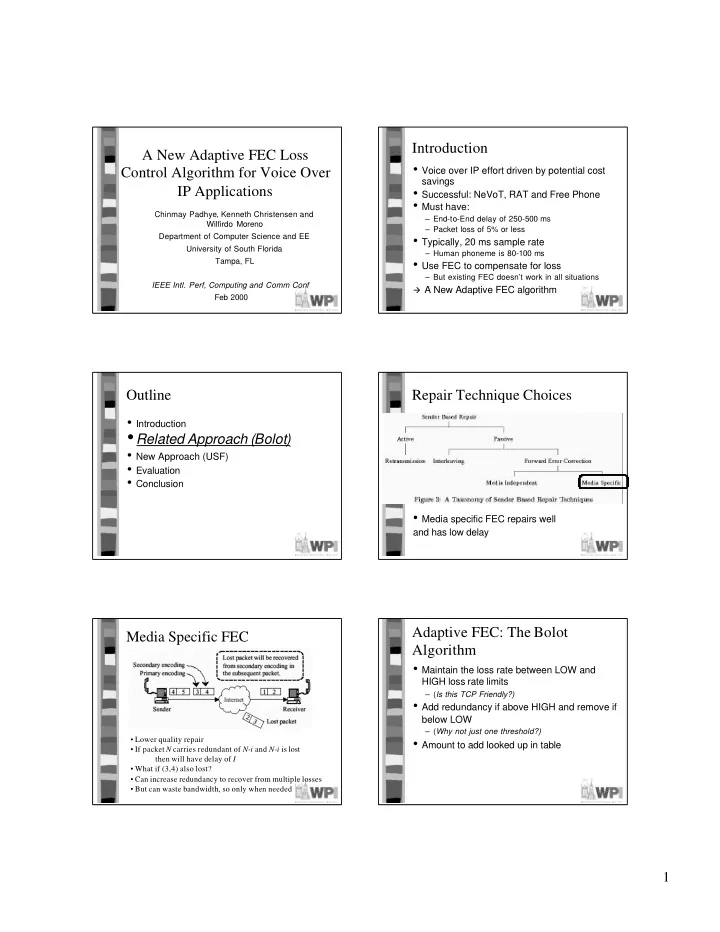

Introduction A New Adaptive FEC Loss • Voice over IP effort driven by potential cost Control Algorithm for Voice Over savings IP Applications • Successful: NeVoT, RAT and Free Phone • Must have: Chinmay Padhye, Kenneth Christensen and – End-to-End delay of 250-500 ms Wilfirdo Moreno – Packet loss of 5% or less Department of Computer Science and EE • Typically, 20 ms sample rate University of South Florida – Human phoneme is 80-100 ms Tampa, FL • Use FEC to compensate for loss – But existing FEC doesn’t work in all situations IEEE Intl. Perf, Computing and Comm Conf � A New Adaptive FEC algorithm Feb 2000 Outline Repair Technique Choices • Introduction • Related Approach (Bolot) • New Approach (USF) • Evaluation • Conclusion • Media specific FEC repairs well and has low delay Adaptive FEC: The Bolot Media Specific FEC Algorithm • Maintain the loss rate between LOW and HIGH loss rate limits – ( Is this TCP Friendly?) • Add redundancy if above HIGH and remove if below LOW – ( Why not just one threshold?) • Lower quality repair • Amount to add looked up in table • If packet N carries redundant of N-i and N-i is lost then will have delay of I • What if (3,4) also lost? • Can increase redundancy to recover from multiple losses • But can waste bandwidth, so only when needed 1
Bolot Algorithm Bolot FEC Combinations • RTCP packets carry number packets loss last 5 seconds • (0,1) means primary packet 0 and redundancy packet 1 • Reward is %loss before / %loss after - empirically (Note! No notion of low quality) Adaptive FEC: The New USF Shortcomings of Bolot Algorithm Algorithm • “Build upon” Bolot (key phrase) • Reward is based on empirical results • Use RTCP with two extensions – Current network may be different – Number of packets lost after reconstruction • Many burst losses of 10 or greater packets – Number of packets lost in loss bursts – FEC cannot recover – Increasing redundancy a waste of bwidth • Increase delay first • Even with LOW and HIGH may still have • Increase redundancy next cyclic (add/remove redundancy) behavior USF Outline Alg. • Introduction • Avoid adding • Related Approach (Bolot) during bursts • New Approach (USF) • Evaluation • Conclusion • Should prevent cycles 2
Evaluation: Simulate Effect on Simulation Results on Internet Network Traces • Simulate network with empirical traces – Audio conference • LOW and HIGH at 3% for USF and Bolot + (used probes, too?) • MINIMUM_THRESHOLD 3% for USF – Receiver at Umass Amherst – Sender at LA, Seattle (20 ms) and Atlanta (40 ms) – Synthetic (queuing model) – Loss rates 1.4% to 3.8% • Simulate network with synthetic traces – Get higher loss rates 1.7% to 35% • 4:6 interactive To bulk • Audio 20 ms, others expn. • USF has ½ to 1/3 as much loss Packets Lost After Simulation Results on Internet Reconstruction Traces Bolot USF • How often loss above HIGH mark? USF better Bolot better Simulation Results on Synthetic Simulation Results on Synthetic Traces Traces •Target loss rate is 3% • USF better for low loss. • Same for high loss (Accuracy of Bolot reward prediction?) 3
Error in Packet Loss by Bolot Tuned Bolot Algorithm • USF still better (If we fix this (specific for these traces), better? Tuned Bolot Algorithm Conclusions • Bolot uses empirical trace and independent loss assumption • USF dynamically changes redundancy in stream based on loss measured • Detects bursts of loss and ignores • USF works better than Bolot for loss rates of 1.5% to 35% (Me: implied benefits from combos or bursts…) Future Work • Quantify bandwidth savings – FEC had no impact on loss here • More packet traces • Quantify setting thresholds • Benefits to real audio in user study • (Me: Adaptive FEC based on available bandwidth) 4
Evaluation of Science? • Category of Paper • Science Evaluation (1-10)? • Space devoted to Experiments? 5
Recommend
More recommend